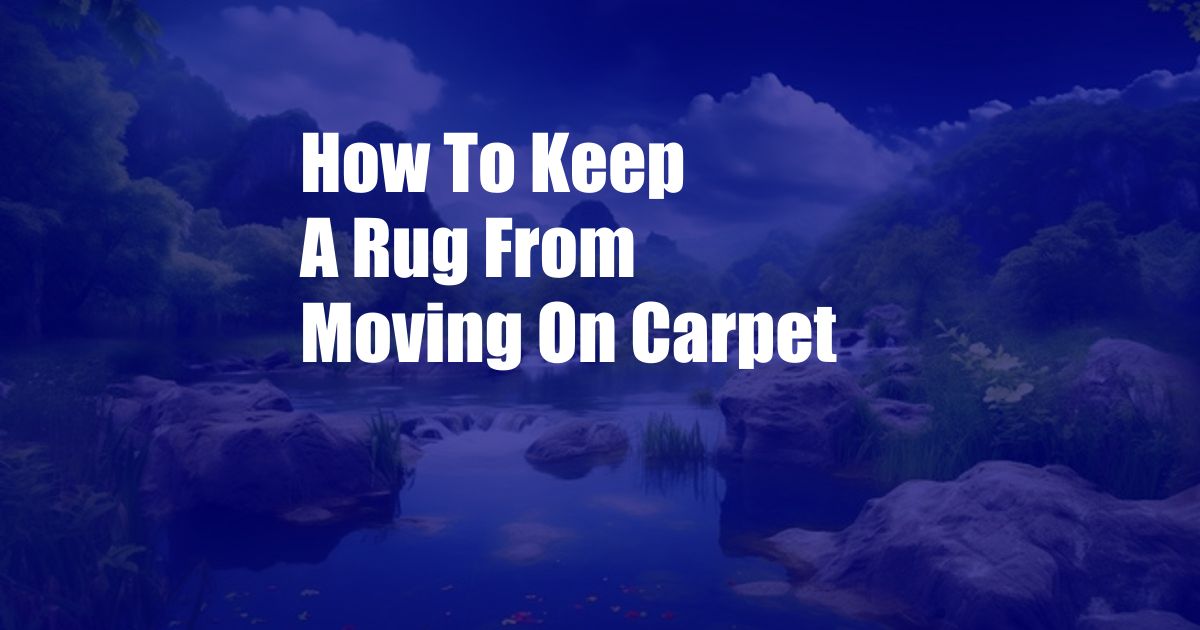
How to Keep a Rug from Moving on Carpet: A Comprehensive Guide to Say Goodbye to Rug Slippage
Have you ever experienced the frustration of your rug constantly shifting and sliding underfoot? This can be a real annoyance, especially in high-traffic areas where the rug tends to move around a lot. Fortunately, there are several effective methods to keep a rug from moving on carpet, allowing you to enjoy a stable and secure floor covering.
In this comprehensive guide, we will explore various techniques to prevent rug movement, discuss the latest trends and developments in rug anchoring, and share practical tips and expert advice to help you keep your rugs in place. Get ready to bid farewell to rug slippage and embrace a more convenient and comfortable living space.
Understanding Rug Movement on Carpet
Before delving into solutions, it’s helpful to understand the factors contributing to rug movement on carpet:
- Friction: Friction between the rug and carpet plays a crucial role in keeping the rug in place. A lack of friction can lead to easy movement.
- Pile Height: High-pile carpets provide less friction compared to low-pile carpets, making rugs more prone to movement.
- Underlayment: Proper underlayment can enhance friction and prevent rug movement.
- Foot Traffic: Heavy foot traffic can loosen the grip between the rug and carpet, leading to slippage.
Time-Tested Methods to Prevent Rug Movement
Now that we have a better understanding of the causes, let’s explore some effective solutions:
- Rug Pad: A rug pad placed under the rug provides extra friction, preventing movement. Choose a rug pad with a non-slip backing to maximize stability.
- Double-Sided Tape: Applying double-sided tape to the corners of the rug and the carpet creates a strong adhesive bond, keeping the rug securely in place.
- Tack Strips: Tack strips installed around the perimeter of the room under the carpet provide anchor points for the rug, preventing movement.
- Non-Slip Rug Underlayment: Specifically designed non-slip underlayments are available in the market, providing exceptional grip and stability.
- Heavy Objects: Placing heavy objects, such as furniture, on top of the rug can help weigh it down and minimize movement.
Expert Tips for Maximum Stability
In addition to the above methods, here are some additional tips from experts:
- Choose a rug size that fits the space well. A rug that is too small is more likely to move, while a rug that is too large may bunch up.
- Rotate your rug periodically to distribute wear and prevent the formation of creases or wrinkles that can contribute to movement.
- If you have a large rug, consider using multiple rug pads to provide even support and prevent shifting.
- For rugs placed on stairs, use non-slip stair treads to enhance safety and prevent movement.
Frequently Asked Questions
- Q: Can I use duct tape to keep my rug from moving?
A: While it may provide a temporary solution, duct tape is not recommended for long-term use as it can damage both the rug and the carpet.
- Q: What is the best rug pad for preventing movement?
A: Look for a rug pad with a non-slip backing made of materials like PVC, rubber, or felt for optimal friction and stability.
- Q: How often should I clean my rug pad?
A: Regular cleaning of your rug pad removes dirt and debris that can reduce its effectiveness. Aim to vacuum or hand-wash the rug pad every 6-12 months.
- Q: Can I install tack strips myself?
A: Installing tack strips requires some DIY experience and tools. If you are not comfortable doing it yourself, consider consulting a professional carpet installer.
Conclusion: Anchoring Your Rugs with Confidence
With the knowledge and techniques shared in this guide, you can effectively keep your rugs from moving on carpet. Say goodbye to slipping and sliding, and hello to stable and secure floor coverings that enhance both comfort and aesthetics. Whether you choose rug pads, double-sided tape, tack strips, or a combination of methods, there is a solution that suits your specific needs.
Remember, a well-anchored rug not only prevents accidents but also adds a touch of sophistication to your living space. So, take the time to implement the tips and advice provided, and enjoy the peace of mind that comes with knowing your rugs are firmly in place.
Are you ready to keep your rugs in place and elevate your home decor? Share your thoughts and experiences in the comments below. Your feedback and questions help us create more informative and engaging content.